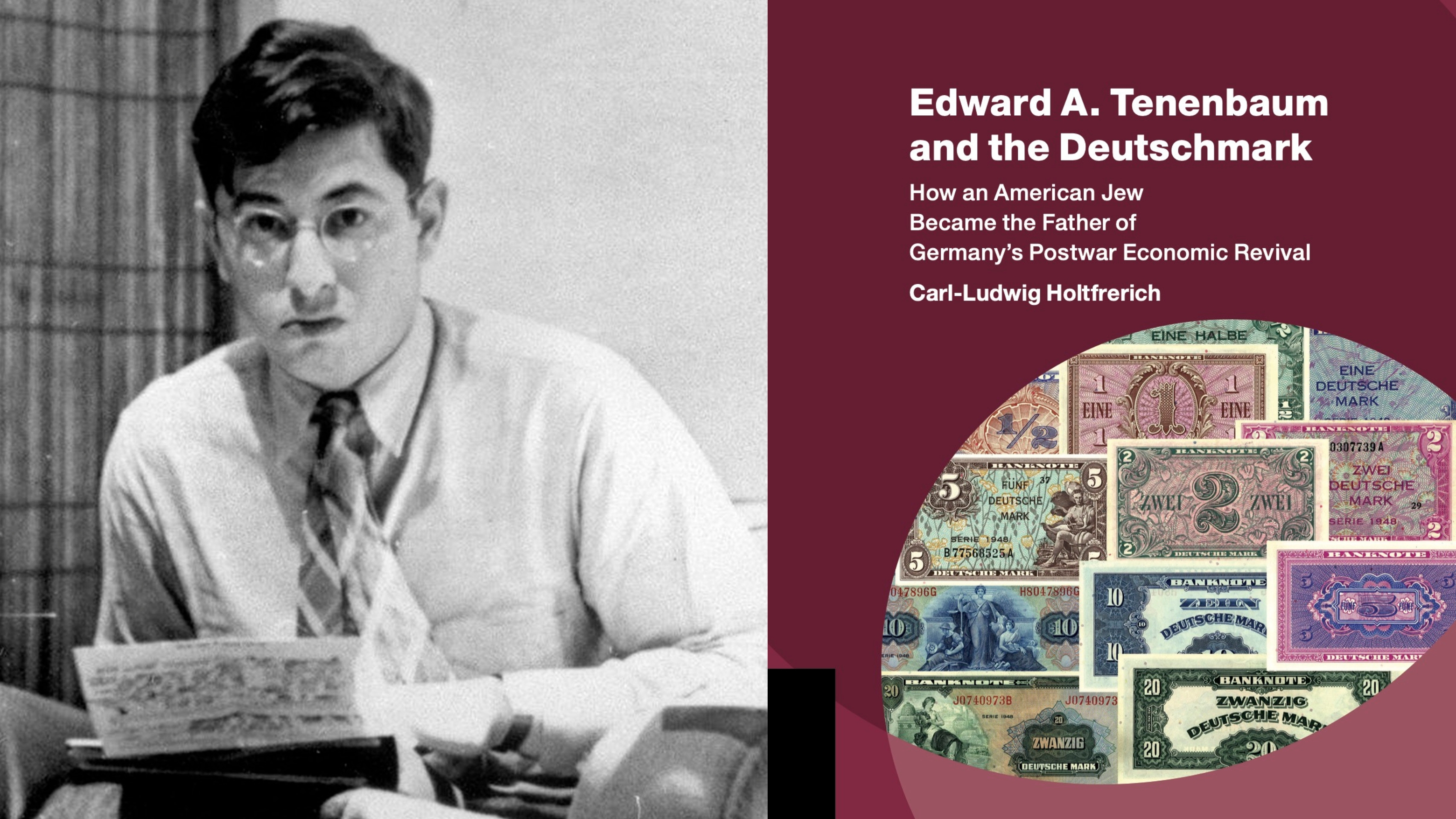In a fresh release from INET’s book series with Cambridge University Press, renowned German economic historian Carl-Ludwig Holtfrerich uncovers the startling truth behind German currency reform usually hailed as the foundation of the post-war German economic miracle: Ludwig Erhard, who cooperated with the Nazis, unjustly claimed the spotlight, overshadowing the real architect, Edward Tenenbaum.
In the chaotic aftermath of World War II, Germany spiraled into a nightmare of economic disarray. The Nazis’ reckless policies inflated the currency to absurd levels, leaving everyday citizens unable to afford even the most basic necessities. In this hellscape, currency reform emerged as a desperate lifeline—a bid to restore market normalcy and ease the suffering of a shattered nation.
Yet, the real champion of that all-important currency reform isn’t the figure most Germans think it is —not the man whose name is celebrated on streets and monuments, Ludwig Erhard, West Germany’s first economics minister.
Enter Carl-Ludwig Holtfrerich, a prominent German economic historian ready to peel back the layers of historical amnesia. In his book, Edward A. Tenenbaum and the Deutschmark, he reveals a surprising truth: the real mastermind behind the 1948 currency reform was not Erhard, a man whose CIA files have revealed his cooperation with the Nazis, but Edward A. Tenenbaum, a young American Jew whose contributions have been largely forgotten. While Erhard styled himself as the architect of West Germany’s economic miracle—a myth celebrated by the Christian Democratic Union, the country’s largest political party—Holtfrerich exposes the buried reality, one suppressed in part due to deep-rooted anti-Semitism.
With his ground-breaking research, Holtfrerich uncovers the story of Tenenbaum’s erasure, taking aim at the falsehoods that have distorted our understanding of German and American economic history.
Lynn Parramore: Let’s start by setting the scene. The war ends in 1945, Germany lost. What kind of economic and financial conditions are the German people facing? What has Nazi economics done to their day-to-day lives?
Carl-Ludwig Holtfrerich: Living conditions in Germany from the end of the war until currency reform were extremely bad. The Nazis had inflated the currency to fund the war, resulting in large amounts of currency compared to the more stable times of, say, around 1935.
In 1936, prices as well as wages had been fixed by the Hitler government. If you have a flood of money with price controls in place, then there is a desperate shortage everywhere, on any item. Rent control is an example of this. When you control the rent, many people would like to have an apartment at that price, but they can’t get it. This was true in Germany for every single item, food, clothing, and furniture, and so on.
My parents married in 1940, and they were unable to get furniture. They had found an apartment, but they couldn’t get the furniture, because that was in short supply. If we hadn’t had a relative with a furniture factory, there would have been no chance to get it.
Food was in short supply also. There were ration cards, which were much more important than money. Everybody had plenty of money, but food was rationed, clothing was rationed, everything was rationed.
So the American military government and Edward Tenenbaum, serving as its currency expert, were eager to implement currency reform. Their goal was to liberate the markets from strict controls and restore normal supply-and-demand conditions in Germany. That was the whole purpose of the currency reform, to get market prices again, and thereby unleash production incentives and stop shortages.
LP: Can you say a little about the players in the currency reform? Who is on board and who is not on board?
CH: Well, one clause of the 1945 Potsdam Agreement of the victorious powers (France was not invited) was that the Soviet Union, the United States, and Britain would govern Germany as an economic unit. That meant that there should be – with France - a four-power currency reform. The Allied Control Council, responsible for governing Germany, consisted of representatives from the four Allied powers and planned to implement a currency reform for all of Germany.
In September 1946, the French opposed the currency reform plan put forth by the American military government to the Allied Control Council. They feared a unified Germany, which could emerge as a much stronger economic power in Europe and overshadow French influence. So they voted against all kinds of measures that would treat Germany as a single economic unit. Ultimately, from 1947 until the implementation of currency reform in West Germany in June 1948, the Soviets refused to support a common currency reform for all four occupation zones.
The Soviet military government in Berlin, represented in the Allied Control Council, often reached agreements with the Western powers. However, Moscow would later intervene and express discontent with these arrangements. Moscow wanted to have a hand in the economic power of Western zones. So they had an interest in a common currency reform, but they wanted to have it their way and not according to the American plan.
The American reform plan was called the Colm-Dodge-Goldsmith (CDG)-Plan. Joseph Dodge was Director of the Finance Division of the American military government in Berlin and later president of the American Bankers Association. The other two, Gerhard Colm and Raymond Goldsmith, were Jewish Germans who had emigrated to the United States early on in 1933 and 1934. They were eminent economists, and they had been asked by the American government to develop the CDG plan for a currency reform in Germany. And at first, the Soviets went along and it was the French that didn’t.
In any case, the CDG plan finally also played a role in Edward Tenenbaum’s reform because it had to be adapted from a four-power currency reform to a three-power currency reform in West Germany only. All the data on population, money supply, and so on had to be recalculated. This was what Tenenbaum did.
Actually, the other two powers, the French and the British, had currency experts in their military governments, too. But it was Tenenbaum who was accepted by everybody as the leading person after the decision had been taken in March 1948 that there would be a currency reform in West Germany only instead of a four-power currency reform.
In April 1948, Tenenbaum effectively imprisoned 11 West German currency experts with support staff for seven weeks in barracks on an American airfield near Kassel. They were completely cut off from their families, from the rest of Germany. In total secrecy, they aided Tenenbaum in adjusting his currency reform plan to German language and conditions.
The main reason for secrecy was that the Soviets should not get a clue that this was happening. The fear was that if the Soviets learned of the planning, they would implement a currency reform in their Eastern Zone first. This would harm the Western Zones, as old Hitler currency would flow into their area, where it would still be legal tender. This would increase the amount of money that a Western currency reform would have to deal with. Therefore, the Western powers wanted to be the first movers and dump a flood of old money on the Soviet zone instead.
LP: Given Tenenbaum’s essential role in all this, it’s curious that he tends to be overlooked. His name hardly ever appears in histories of German currency reform.
CH: Well, actually, Tenenbaum left Germany and the American military government by the end of August 1948, practically ten weeks after the currency reform, to work in Washington for the Marshall Plan administration. And he was the opposite of a vain person. He was a rather shy character. He never wanted to stand in the limelight. He wanted to conduct his business behind the curtain. Actually, he was asked in an interview in the 1950s whether he regretted that he was not credited for the currency reform in Germany by Germans. He said: “Who cares who gets the credit?” That was his attitude.
LP: Let’s talk about Ludwig Erhard, who has long been celebrated as the architect of West Germany’s economic recovery and for playing a pivotal role in the introduction of the Deutschemark in 1948, which helped stabilize the German economy. Is that accurate?
CH: Erhard met Tenenbaum only three or four times. What Erhard did was to order the end of price controls after the West German currency reform. He did that because the American military government couldn’t do it alone, as it was tied with the British military government in the so-called Bizone, as it was called, the fused two Anglo-Saxon occupation zones.
The British would not have gone along with the price lifting because they had their labor government and lifting price controls was not on the agenda of the labor government in Britain itself. They knew that the removal of price controls would initiate quite a dynamic economic development in Germany. The British, like the French, didn’t like that either.
General Lucius Clay, the military governor for the Americans in Germany, was a very smart man politically. He wanted to democratize Germany, so he set up institutions that were precursors to a German parliament, government, and so on. There was the economics administration, the forerunner of the economics ministry of the Federal Republic of Germany, which was to be founded in 1949. Clay let free-market advocate Erhard become the director of that institution. From the Economic Council, composed solely of German delegates and serving as a precursor to a West German parliament still under Anglo-Saxon oversight, Erhard insisted on—and secured—the right to lift price controls whenever the time was right. He made use of that right a few days after currency reform.
Clay ordered Erhard to come to his office and reprimanded him for it. But in actuality, he liked it. He wanted it. Letting Erhard do it was a way to get around the British, who would have vetoed the lifting of price controls. And once Erhard had ordered the lifting of price controls, the two powers, the British and the Americans, could have stopped it only by a unanimous veto. But Clay had no interest in complying with the British position on that issue.
This is a prime example of Clay’s knack for constructing stages for political decision-making, where dramas are played out in one’s own interests.
LP: Erhard’s past work under the Nazis has attracted little attention. In your research, you found important files that no other historian had ever been able to consult, especially from the CIA. What do those reveal about Erhard’s past?
CH: Ludwig Erhard, since 1949 West Germany’s first and long-time economics minister and, finally, chancellor from 1963 to 1966, had never been a member of a Nazi organization. That’s why the American military government in the US occupation zone entrusted him with leading positions in newly built German political institutions. But their secret service caught up with the cooperation that Erhard had maintained with the highest Nazi offices, like those of SS chief Heinrich Himmler and Hermann Göring, who had been appointed as Hitler’s successor.
Charged with preparing an expert report on how to integrate parts of occupied Polish territory into Germany and its economy, he spent some time in that particular part of Poland. There he witnessed not only atrocities and murders committed against Jews but also the expropriation and expulsion of the Polish population from that part of Poland as well as the compulsory recruitment of Poles for forced labor in Germany. Accepting all this, Erhard begged Himmler’s office for an official appointment as an economic expert for many months before he got it. Aided by a competent archivist of the National Archives, I was the first researcher who saw what the CIA had collected over many years on Ludwig Erhard’s personality, political strengths and weaknesses, and on his role in supporting Nazi economic policies. I was taken completely by surprise when I spotted Erhard’s name on a CIA summary list of the most prominent Nazi war and human rights criminals, in alphabetical order right after Adolf Eichmann, who was captured by Israel’s Mossad in Argentina in 1960 and sentenced to death for his role in organizing the Holocaust.
LP: Your book restores Tenenbaum’s legacy as the true father of the Deutsche Mark. Why is it essential to correct the historical record? Did anti-Semitism contribute to the oversight of Tenenbaum’s achievements?
CH: I think it did play an important role. During the 12 years of their reign and even before during the Weimar Republic, the Nazis had indoctrinated the German population that the Jews were the root of all German problems. And many people came to believe it. You don’t get that out of brainwashed minds within three years after the end of Nazi rule. It takes at least a generation, i.e. 30 years. I think that the fact that Tenenbaum was Jewish played the main role in suppressing his merit and preventing his appearance in German history. I hope this book contributes to changing that.
There are hundreds of streets and bridges, squares and places as well as buildings and schools named after Ludwig Erhard in Germany. But there is only one street — and only since about 15 years — which is named after Edward A. Tenenbaum.







